Aquatic crab pets are a fun addition to a freshwater tank. They fill the tank with activity and colors. With many benefits, their unique appearance makes them a focal point of the tank. Fun species, selection, tank setup, and maintenance are difficult aspects of keeping crabs as pets. This article will address all of these issues.
Content Table
Aquatic Crab Pets
Aquatic pet crabs are crustaceans that aquarists keep in their tanks. There are about 7,000 different crab species from 100 different families. They are either freshwater, saltwater, or semi-aquatic. About 1,300 are freshwater crabs. These crabs are usually found in tropical and subtropical regions in various habitats.
They play a pivotal role in environmental balance by cleaning water bodies. They are also a food source for numerous living beings, including the human race. Many species are preferred by aquarists to keep in their tanks. Here are some famous aquarists’ top choices, along with their family, water preferences, and other necessary details.
| Type | Origin | Family | Size | Tank Type |
| Fiddler crab | Worldwide in brackish waters | Ocypodidae | 1–2 inches | Brackish water, semi-aquatic |
| Thai Micro Crab | Thailand | Panopeidae | Up to 1 cm | Freshwater |
| Vampire Crab | Southeast Asia | Sesarmidae | 2–3 inches | Freshwater/semi-aquatic |
| Matano Crab | Sulawesi, Indonesia | Parathelphusidae | 2–3 inches | Freshwater |
| Pom Pom Crab | Indo-Pacific Ocean | Xanthidae | Up to 1 inch | Saltwater/reef tank |
| Panther Crab | Indonesia | Parathelphusidae | Up to 3 inches | Freshwater |
| Red Claw Crab | Southeast Asia | Sesarmidae | 2–3 inches | Brackish water, semi-aquatic |
| Mithrax Crab | Caribbean Sea | Mithracidae | 2–3 inches | Saltwater/reef tank |
| Rainbow Crab | West Africa | Gecarcinidae | 3–4 inches | Semi-aquatic/brackish |
Freshwater Crab Habitat
Yes, there are fully aquatic crabs for freshwater. As mentioned earlier, there are 1300 different freshwater aquatic crab species. They belong to various families and have variable sizes, habitats, colors, and other characteristics. Here is a list of such species.
| Name | Family | Size (inches) | Color | Distribution | habitat |
| Thai Micro Crab | Hymenosomatid | 0.4–0.6 | Greyish-brown with bristle-like hair on translucent legs | Chin River, Thailand | Heavily vegetated areas with floating aquatic plants |
| Pom Pom Crab | Platythelphusidae | Up to 2 | Brown or light tan with red or orange spots | Hawaiian Islands | Rocky or coral-rich freshwater environments; tolerates brackish conditions |
| Tanganyika Crab | Platythelphusidae | Up to 2.5 | Dark brown to black with light shades | Lake Tanganyika, Africa | Rocky and sandy shoreline at depths of up to 30 meters |
| Panther Crab | Parathelphusidae | Up to 3 | Black and orange markings resembling a panther | Sulawesi Island, Indonesia | Moderate-flow rocky and sandy freshwater environments |
| Matano Crab | Various | Up to 5 inches | Colorful with variations within the species | Lake Matano, Sulawesi, Indonesia | Sandy and rocky lake beds |
Fun Addition To An Aquarium Or Paludarium
Here is an introduction to a few fun crab species for fully or semi-aquatic tanks.
Fiddler Crab
| Fiddler crabs are one of the top choices for semi-aquatic environments. They are named after their male asymmetrical claws, while females lack this attribute. They belong to the Ocypodidae family. Atlantic sand, Red-jointed, and Marsh fiddler are popular fiddler aquarium species.
They grow up to 2 inches long in colorful shades, e.g., brown, yellow, red, orange, and blue. They are present worldwide and live in coastal regions. Brackish or saltwater with soft substrate is the best living condition for them. They live for 2 to 3 years. They are burrowers. They use these burrows for shelter, mating, and thermoregulation purposes. These highly social creatures use their claws as a communication tool. They feed on organic matter, algae, and other small particles. Moreover, males use their large claws to attract females in mating season. A 10 to 20-gallon tank with ample sand substrate and dry area is a suitable house for them. Secure the tank with a lid so they can climb on the tank wall. |
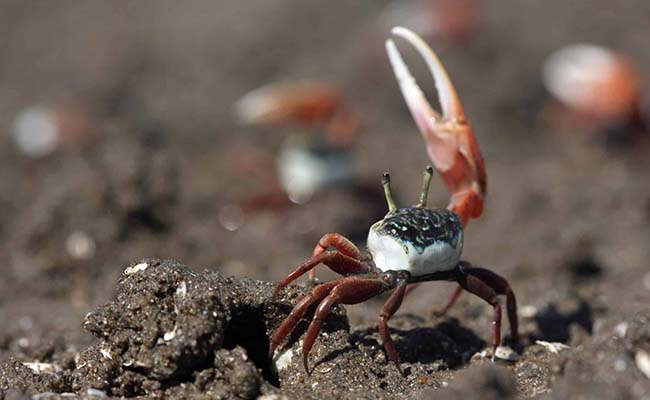 |
Thai Micro Crab
| Thai microcrabs are one of the fully freshwater aquatic crab species. They are native to the River Chin, Thailand. Their natural habitat is heavily vegetated and has floating aquatic plants. Greyish-brown bodies with bristle-like hair on translucent legs give them a special appearance. Their legs are not equal in size.
As the name mentioned, it is small, less than 1 inch, precisely 0.4 to 0.6 inches in dia. In a perfect environment, they live up to 2 years. They are the best choice for the nano freshwater tanks. They are peaceful and non-aggressive toward their companions. They are shy, nocturnal, and prefer to hide themselves. Keep them in a group of 3 to 5 in a minimal 5 or 8 gallon tank. |
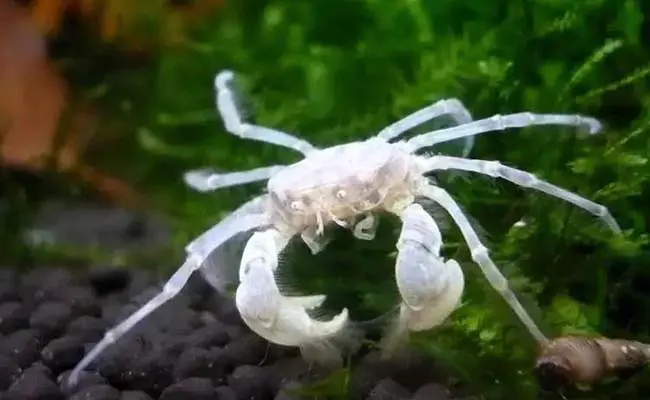 |
Pom Pom Crab
| Pom pom crab, or Ptychognathus Barbatus, is another fully freshwater aquatic crab. These crabs are native to Hawaiian islands and live in rocky or coral-rich environments. They can bear brackish water conditions. They have a brown or light tan body with red or orange spots.
They are another suitable crab species for nano tanks as they can grow up to only 2 inches long. Due to higher activity levels, they can bring life to the tank for at least 2 to 3 years. They have unique filtering pom-pom-like claws. They use it for filtering food particles from the water. They are peaceful, docile, active scavengers, curious, and burrowers. |
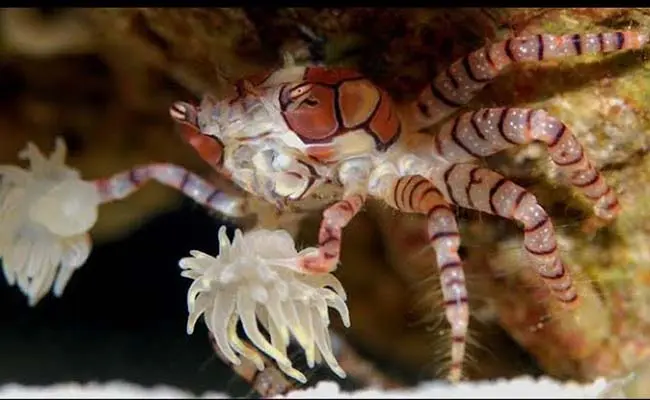 |
Moon Crab
| Halloween crabs or moon crabs are color pets. Their striking coloration makes them attractive to hobbyists. They belong to the Gecarcinidae family. By including the leg spans, they reach up to 6 inches. They are native to Central and South America in coastal regions, mangroves, forests, and estuaries.
They have a deep purple or blue carapace, bright orange or red claws, orange accent black legs, and bright yellow eyes. These semi-aquatic species live up to 10 years in optimal living conditions. These burrowers create tunnels for shelter, hiding, and thermoregulation. They are omnivores, so they consume various types of foods. These nocturnals are territorial. Therefore, it’s best to keep them alone in a tank. Like fiddler crabs, they are climbers, so secure the tank with a lid. At least a 10 or 20-gallon tank with 4 to 6 inches of sandy substrate is the best housing for these crabs. Keep them in large dry regions and small shallow water areas with up to 70% humidity. |
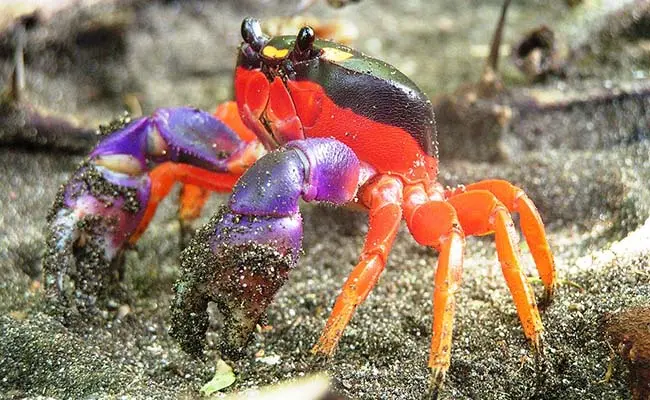 |
Tanganyika Crab
| These crabs are native to one of the oldest and largest freshwater lakes, i.e., Lake Tanganyika, Africa. They live up to 30 meters deep on rocky and sandy shores.
Platythelphusa armata is one of the largest crab species of the lake, with 2.5 inches diameter from the rare legs. They usually live up to 4 years. They have a rough exoskeleton with dark brown to black with light shades. Their claws are larger than their body. They are territorial and don’t prefer to live with other species. They become aggressive in defensive conditions. They are nocturnal and spend most of their time hiding themselves in their defined territory. Keep one crab per tank in a minimum 20-gallon tank. Lay sandy and or fine-gravel substrate that allows them to burrow. |
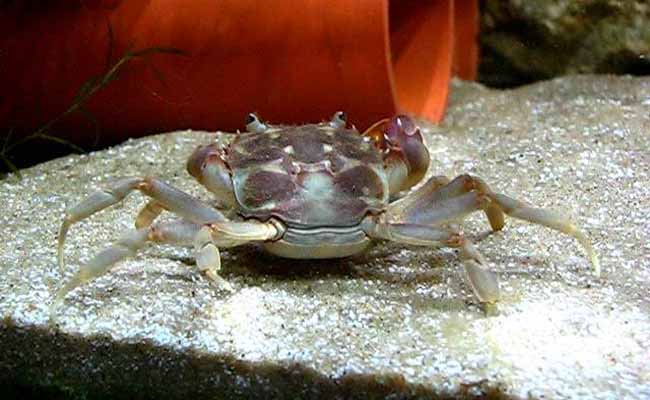 |
Panther Crab
| Panther crabs are native to Sulawesi island of Indonesia. They usually live in moderate-flow rocky and sandy substrate freshwaters. They can gain up to 3 inches dia from the legs and lie under medium-sized aquarium crabs. They can live up to 2 to 4 years.
They have striking black and orange markings that mimic the panther. Their thin and long legs make them more gorgeous. Panther crabs are nocturnal, territorial, and aggressive. Their aggression is visible to other crab species and animals in the tank. They hide themselves or burrow in substrate. You can keep these omnivores in your freshwater tank with moderate care. |
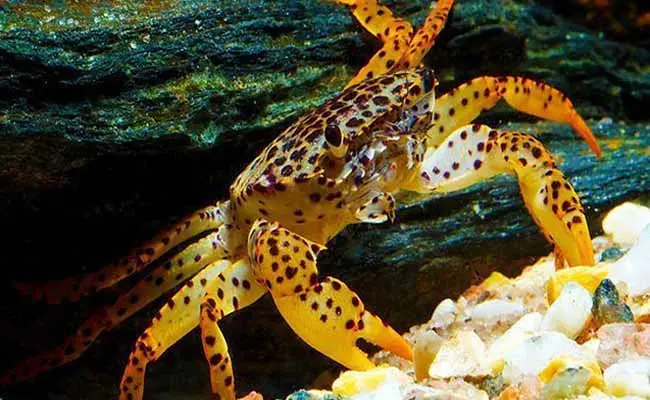 |
Matano Crab
| Matano crabs are native to Lake Matano, Sulawesi, Indonesia. This lake has a sandy and rocky bed. They are one of the largest aquarium carbs, as they can grow up to 5 inches in diameter. In optimal conditions, they live for 2 to 4 years.
They have colorful appearances that vary among the same species. They have large and strong claws for hunting and defense. Moreover, they have a streamlined body. Due to their nocturnal nature, they spend most of the daytime hiding. Moreover, they love to burrow them in the substrate. |
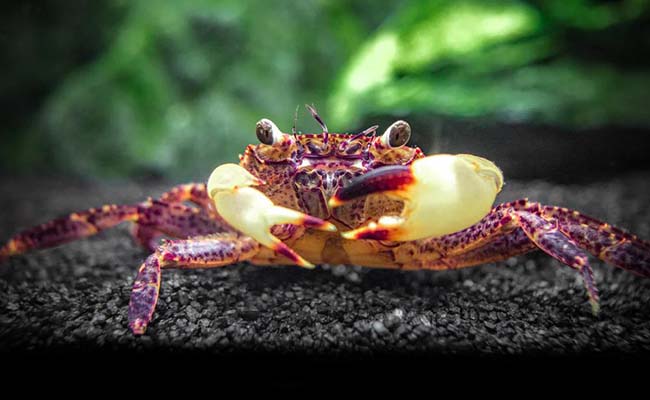 |
What Do Freshwater Crabs Do For Freshwater?
Freshwater crabs impart numerous positive impacts on the freshwater. Here are some of the aspects in which they play a pivotal role.
Tank Cleaning
Crabs are scavengers and consume leftover food. It helps them avoid waste accumulation and ammonia spikes in the tank. Some freshwater crab species also help to control algae growth in the tank as they graze over it.
Substrate Aeration
Numerous freshwater crab species are burrowers. In this way, they improve the substrate aeration. It results in optimal plant growth, substrate health, and the release of harmful gasses.
Maintain the Food Web
Crabs play a pivotal role in the proper functioning of the food web. They prey on small organisms, e.g., detritus and microorganisms. Moreover, they also become prey for the larger fish.
Improve Aesthetics
They improve the tank’s aesthetics with interactive behavior, striking coloration, and a unique appearance. Some species are curious and explore the different parts of the tanks, while some nocturnal species tend to burrow and hide in the substrate and under plants and decorations. Moreover, their vivid coloration and fascinating patterns and appearance add decorative elements to the tank.
Nutrient Recycling
They help to break down the organic waste in the tank and avoid ammonia spikes. It improves the plant growth in the tank. Moreover, their waste acts as a natural fertilizer for plants as it contains nitrogen and phosphorus.
Water Health
Crabs are highly sensitive to water parameters, i.e., Mini chili crab. In any minute change in the parameter, they behave differently, i.e., increase hiding or reduce activity.
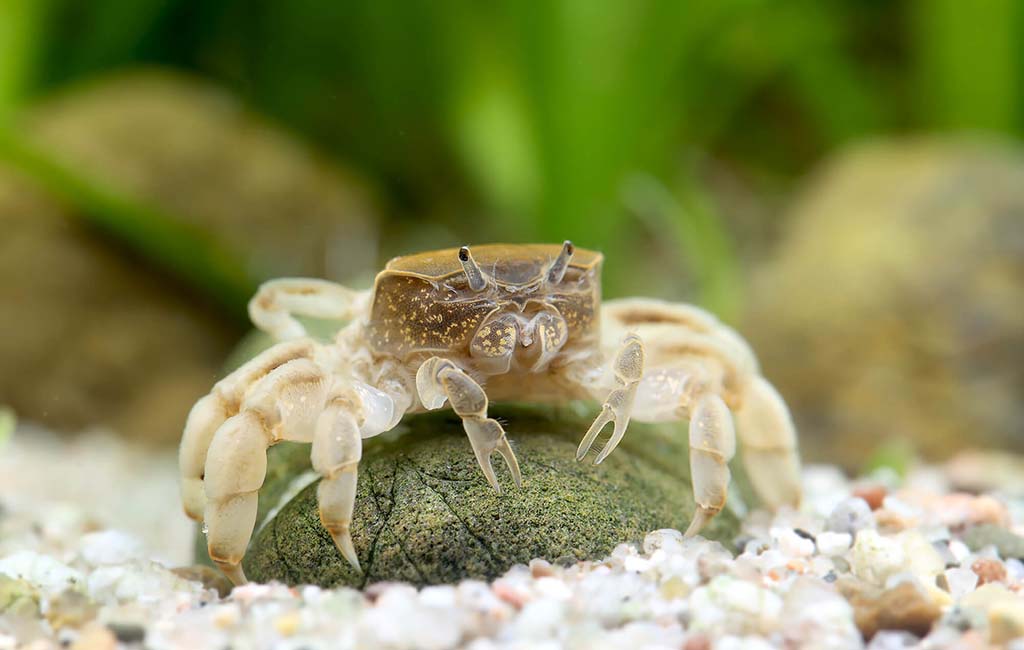
freshwater aquarium crabs
The Easiest Freshwater Crab To Keep In Home Tank
Fiddler Crabs are the easiest crabs to keep in the home tank. However, they need brackish water conditions. They are known for their large claws, which they use as a defense mechanism.
These crabs have smooth and convex carapaces with 8 walking legs. Their coloration varies at different hours of the day. Flow rate also impacts coloration. They are distributed worldwide in tropical and temperate regions and play a vital role in their ecosystems.
Why Is It Easy to Keep Them in a Home Tank?
- They require low maintenance and can live up to 10 years.
- They are suitable for small to medium aquariums.
- It’s fun to observe them as they show variable coloration throughout the day and in different flow rates.
- They require shallow brackish water with small dry land.
- They are docile and suitable to keep in species-only tanks and require minimal feeding.
Freshwater Crabs Care Sheet
Keeping the crabs in your freshwater tank is quite an interesting and joyful journey. However, it needs to take care of them properly. Here is the care sheet for freshwater crabs.
Tank Setup
- Small species can live in at least a 5-gallon tank. While large species require a minimum 20-gallon tank.
- Lay a thick layer of 4 to 6 inches, of fine sand or smooth gravel, as they love to burrow and dig in the tank.
- Introduce some hiding spots in decors, i.e., driftwood, rocks, caves, etc. Densely populated and floating plants do the same job.
- Some species can climb over the tank wall. For such species, use a lid to secure the tank.
- Water parameters vary with species. However, here are general water parameters.
| Parameter | Value |
| Temperature | 72–82°F |
| pH | 6.5–8.0 |
| Water hardness | Moderate or according to specie |
| Flow rate | According to specie |
| Water change | At least 20% weekly |
Diet
Freshwater crabs are mainly omnivores. Feed them 2 to 3 times per week with the balance proportion of the following items.
| Commercial food | Lettuce | Finely chopped fish |
| Spinach | Blood worms | Algae |
| Zucchini | Brine shrimps | Detritus |
Space Allocation
Crabs are generally territorial. Therefore, avoid overcrowding, as it can bring aggressive vibes to the tank. Moreover, they are explorers and scavengers. So, keep them in the same species tank with an adequate male-to-female ratio.
Maintenance and Care
- Weekly change 20% tank water.
- Regularly test the water parameters, e.g., ammonia, nitrite, and nitrate levels.
- Keep it chlorine and heavy metal-free.
- Regularly check the substrate health, as most of them love to hide in the substrate.
Diseases Cure
| Problem | Solution |
| Molting | Provide calcium-rich food |
| Stress | Improve water quality |
| Increase hiding spots | |
| Injuries | Maintain an adequate proportion of the male and female ratio |
| Avoid mixing different species |
Rounding Out the Discussion
Aquatic crab pets bring some fascinating vibes to the tank. They live in fully aquatic and semi-aquatic conditions. Freshwater aquarium crabs are suitable for nano tanks, i.e., Thai Micro crabs, etc. So select the species of your interest, set up the tank according to its requirements, and keep a time-to-time check for the best crab vibes.
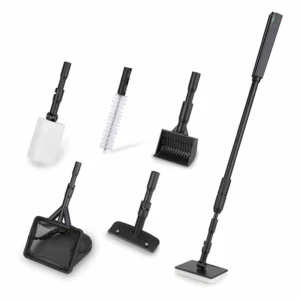
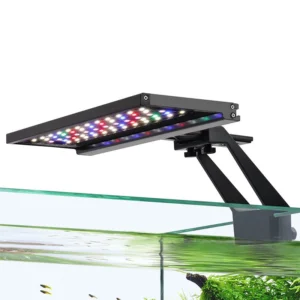
Leave a comment